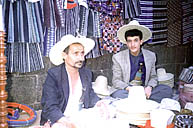
The Business of Weaving and Embroidery in Yemen [Archives:2000/16/Business & Economy]
April 17 2000
Mahyoob Al-Kamali
Embroidery of national popular clothes is an art and profession in Yemen, communicated through successive generations. One of the factors that helped the spread of this profession is the difficulty to find other job opportunities, a matter which forced some sections of our people to turn to practice of this craft.

Hand weaving profession in Yemen is one of the genuine crafts that has become a popular industry depended upon by thousands of families for their livelihood. One remarkable thing is that the new embroidered products have been given new names and decorations while preserving of their traditional features, mixed with a sense of modernity.

A number of sewing and embroidering centers were established in different villages to help women earn livelihood and at the same time preserve this valuable handicraft.
Artisans are intent to apprentice their sons and daughters on the basics of hand weaving including adorning clothes with certain symbols representing natural surroundings, planets, stars, names of God, verses from the Holy Qura’an, prayers to God, etc.
The implementation of the National Center for Protection and Development of Handicrafts in Sana’a is really a timely step forward to protect our heritage and history. The center provides training in various kind of richly embroidered costumes combining artistry and social traditions.
Women have actually excelled themselves in this art for they find it a way of expression of their sensitive feelings and latent talents.

In the West of Yemen, Tehamah, for instance, bridegrooms prefer to wear a cap commonly referred to as a “Khawzaran”. It is made of palm leaves and is embroidered with some colorful threads that bestows on the wearer a magnificent beauty.
There are special costumes for old people as well; for example, there are special robes to be put on their shoulders in religious as well as social ceremonies. Such costumes lend on old people a sense of reverence.
There are many types of such costumes made for me, most popular of which is “Zanah” meaning a brocade. It is an embroidered garment made of silk with golden threads ornamenting sides of the garment.
This garment has assumed different textures in different parts of Yemen; for example, in many workshops in Sana’a, this garment takes a circular shape covering the lower part of man’s body.
In Hadramout it takes the same shape and is referred to as “Ma’awaz”. In other places it is called “Fotah”.
In fact, each part of Yemen has been famous for a special craft that its people are skilled at.
In general, most of the those practicing these handicrafts import silk from Iran. Most of them use traditional tools made of wood; in addition to imported weaving and embroidery equipment.
Visitors to such markets are much impressed to see such hand-made products by women, who are usually skilled at embroidery, particularly brides’ clothes. Most of the embroidery are made to match beauty of nature. You can see, for example, some bees that have been magnificently woven to indicate the honey moon. However, embroidery vary from one area to another.
There are also different women’s dresses, for example, there is the Sana’ani veil, dress, nightdress, pantalets which have lots of embroidery at the bottom.
In some areas of Yemen there is a belief that the bride and the bridegroom have to wear costumes on which names of God and verses from the Holy Qura’an have been embroidered which would protect them from envy. The bride does also wear some gold as well as silver jewelry.
Silk-made carpet industry is one of the common handicrafts in Yemen. Most often one finds that these carpets are embroidered with religious and historical verses that perfectly match the furniture of traditional houses.
Therefore, preserving these handicrafts has become an important issue not only to maintain and sustain livelihood of those working in this profession but also to boost tourism industry in our country. Thus, the government as well as donor countries should give such crafts the attention needed to keep them alive.
——
[archive-e:16-v:2000-y:2000-d:2000-04-17-p:./2000/iss16/b&e.htm]


